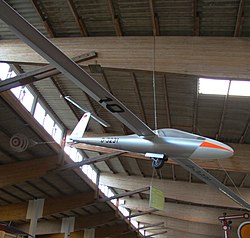Milomei M1
| Milomei M1 | |
|---|---|

|
|
| Type: | Glider |
| Design country: | |
| Manufacturer: |
Meier / Teusch / Lohner |
| First flight: |
June 8, 1966 |
| Number of pieces: |
1 |
The Milomei M1 is a single-seat German glider . It was made in amateur construction by aeronautical engineer Michael Lorenz Meier (1937–2008), Klaus Teusch and Herbert Lohner.
history
The construction took place between 1963 and 1966 in the workshop of the Hamburg Aeroclub Boberg. Meier joined this club in 1952 at the age of fifteen and one of his flight instructors was world gliding champion Heinz Huth . There the small machine was made entirely of metal. The first flight took place on June 8, 1966. A few days later it was presented to the public at the World Gliding Championships in Roth. The M1 was in service until 1976 and achieved only 113 flight hours with 170 starts. The sight is said to have tempted some veteran glider pilots and aircraft builders (allegedly Eugen Hänle ) in Roth in 1966 to the sentence "If the thing flies, we have all the others built wrongly so far". Today it is owned by the Mobile Welten e. V. in Hanover.
construction
The reason for this saying is the extremely slim rectangular wing, which is only 50 cm deep. On the trailing edge of the wing there are narrow flaps over almost the entire span. Only the slightly trapezoidal wing tips have no flaps. It is not clear to what extent these take over the function of flaps, ailerons or flaperons . A photo shows the M1 with the flaps lowered by approx. 45 ° over the entire span, which suggests an overlay mechanism. The inner flaps should have been extendable up to 90 ° for the landing. Another interesting facility is the pendulum T-tail. The rudder rotates around a tube, which in turn contains the linkage and fastening of the elevator. The rudder had to be replaced with a slightly larger one during testing. The wing is built as smooth as possible, as a landing aid only a ribbon braking parachute is available. The wing is profiled with the 14% thick Eppler profile E-303. The cockpit is generously glazed up to the trailing edge of the wing, the machine has a retractable landing gear.
Technical specifications
| Parameter | Data |
|---|---|
| crew | 1 |
| length | 5.86 m |
| span | 13.00 m |
| Wing area | 6.5 m² |
| Wing profile | Eppler E-303 |
| Elongation | 26th |
| Empty mass | 165 kg |
| Max. Takeoff mass | 280 kg |
| Wing loading | 40.77 kg / m² |
| Glide ratio | 37.5 at 104 km / h |
| Slightest sinking | 0.8 m at 90 km / h |
| Top speed | not known |
Milomei M2
The Milomei M1 was a radical design for the then planned 13-meter mini-class (which never came about). Skills such as slow and tight circles in weak updraft areas were definitely not part of their specifications. Meier therefore later designed the Milomei M2 for the open class. The M2 was designed no less radically than its predecessor. With a wingspan of 22 m, it had a wing of variable depth, whereby the area could be increased by 40%. Aspect ratio 28/39, wing area 12.2 / 17 m². The machine flew for the first time in 1981, achieved a best glide ratio of 49 and had a maximum speed of 290 km / h.
literature
- Dietmar Geistmann: The gliders in Germany. Motorbuchverlag, Stuttgart 1979, ISBN 3-87943-618-5
